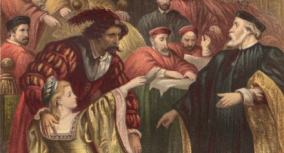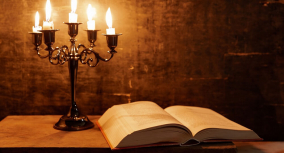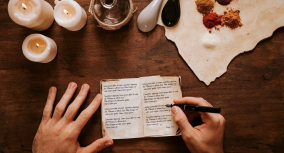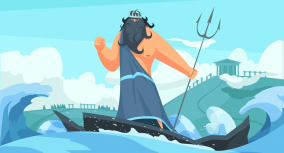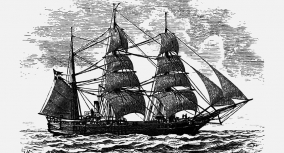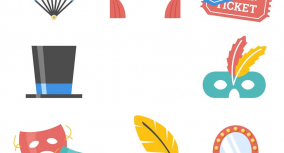The key symbols in Othello include animals, a handkerchief, and the Willow Song. Shakespeare uses symbolism to underscore the play’s central themes, such as gender and racism. For example, Mirka Cirovic (2022) argues that animals serve as symbols that represent Othello’s perceived otherness. When Iago describes Desdemona as a “white ewe” and Othello as a “black ram,” he emphasizes their difference in race and age, transporting the undesirable animal characteristics onto the play’s protagonist.
On this page, you will find a detailed analysis of Othello‘s symbols and imagery. Custom-Writing.org experts will:
- Explore the dual meaning of Desdemona’s handkerchief
- Interpret the Willow Song
- Examine the animal imagery in the play

Read on to learn more about symbols associated with Othello, Cassio, Iago, and other characters.
Handkerchief
Desdemona‘s handkerchief is one of the most complex Othello symbols. Its uniqueness lies in the diversity of meanings it reflects.
Originally, the handkerchief was made by an old female prophet. According to Othello’s stories, the dye was extracted from the hearts of mummified virgins. Thus, the initial meaning lying behind the handkerchief is virginity and purity.
Othello claims that he got the handkerchief from his mother. She believed that it helps to make the family members faithful to each other. So, from this perspective, the handkerchief represents loyalty and immovable family ties.
When Othello got married to Desdemona, he presented the handkerchief to his wife as a love token. Othello believes that while she possesses his present, she is chaste. However, if the woman loses it, she becomes unfaithful. Therefore, in this context, the handkerchief reflects the spouses’ sincere feelings and marital fidelity.
Nevertheless, with the progress of the storyline, the handkerchief’s meaning loses its high moral value. From the symbol of love and chastity, it turns into a representation of jealousy and disloyalty.
One evening, Othello was complaining about a headache. Trying to relieve the pain, his wife started bandaging his head with the tissue. This act of service represents Desdemona’s care about Othello. The handkerchief appeared on the floor after Othello rudely pushed it away, thinking about his wife’s betrayal. At that moment, Emilia’ takes the tissue. Trying to satisfy Iago, she steals it from Desdemona. Hence, for Emilia, the handkerchief is a symbol of betrayal.
When Othello’s present for Desdemona appears at Iago, the storyline turns in another direction. Through manipulation, Iago transforms the piece of tissue into a powerful weapon. He persuades Othello of Desdemona’s adultery and provides the handkerchief as an “ocular proof.”
Overall, the handkerchief in Othello is the most dominant symbol. Having a multifaceted nature, it symbolizes various things and leads to many deaths.
Quotes about Handkerchief
IAGO
Othello, Iago and Othello, Act 3, Scene 2
Nay, but be wise: yet we see nothing done;
She may be honest yet. Tell me but this,
Have you not sometimes seen a handkerchief
Spotted with strawberries in your wife’s hand?
OTHELLO
I gave her such a one; ’twas my first gift.
IAGO
I know not that; but such a handkerchief –
I am sure it was your wife’s – did I to-day
See Cassio wipe his beard with.
DESDEMONA
Othello, Desdemona and Emilia, Act 3, Scene 4
Where should I lose that handkerchief, Emilia?
EMILIA
I know not, madam.
DESDEMONA
Believe me, I had rather have lost my purse
Full of crusadoes: and, but my noble Moor
Is true of mind and made of no such baseness
As jealous creatures are, it were enough
To put him to ill thinking.
OTHELLO
Othello, Othello, Act 3, Scene 4
That is a fault.
That handkerchief
Did an Egyptian to my mother give;
She was a charmer, and could almost read
The thoughts of people: she told her, while
she kept it,
‘Twould make her amiable and subdue my father
Entirely to her love, but if she lost it
Or made gift of it, my father’s eye
Should hold her loathed and his spirits should hunt
After new fancies: she, dying, gave it me;
And bid me, when my fate would have me wive,
To give it her. I did so: and take heed on’t;
Make it a darling like your precious eye;
To lose’t or give’t away were such perdition
As nothing else could match.
DESDEMONA
Othello, Desdemona, Act 3, Scene 4
Sure, there’s some wonder in this handkerchief:
I am most unhappy in the loss of it.
OTHELLO
Othello, Othello, Act 3, Scene 3
Villain, be sure thou prove my love a whore,
Be sure of it; give me the ocular proof.
Willow Song
Among all the symbols in Othello, the Willow Song is the most dramatic one. It tells the sad story of a woman who died because of fierce love and her man’s disloyalty. Thus, the song reflects the heartache and betrayal.
The readers first hear the song from Desdemona in act 4, scene 3. The woman knows it from her mother’s maid – Barbara. She was suffering from tough love and ultimately died singing the Willow Song.
In the play, Desdemona sings this song while changing the bedsheets. Feeling how cold and rude Othello has become, she decides to provoke the old emotions. She changes the regular sheets to the wedding ones. Desdemona believes that it will remind Othello of their love and strengthen their marriage. Here is where the readers can trace the symbolism of the wedding sheets in Othello.
A terrible sense of foreboding makes Desdemona song the Willow Song. In the play, Desdemona’s song functions as foreshadowing. It presages a tragedy caused by Othello’s cruel jealousy.
Later in the play, Emilia refers to the Willow Song. After revealing the truth about Iago’s villainy, she is stabbed by her husband. So, dying over Desdemona’s deathbed, Emilia sings this song. By doing this, she highlights the destructive nature of jealousy that kills innocent people.
Willow Song’s meaning is crucial for the play. It indicates the horrendous fates of Desdemona and Emilia and their husbands’ cruelty.
Quotes about Willow Song
DESDEMONA
Othello, Desdemona, Act 4, Scene 3
My mother had a maid call’d Barbara:
She was in love, and he she loved proved mad
And did forsake her: she had a song of ‘willow;’
An old thing ’twas, but it express’d her fortune,
And she died singing it: that song to-night
Will not go from my mind; I have much to do,
But to go hang my head all at one side,
And sing it like poor Barbara. Prithee, dispatch.
DESDEMONA
Othello, Desdemona, Act 4, Scene 3
[Singing] The poor soul sat sighing by a sycamore tree,
Sing all a green willow:
Her hand on her bosom, her head on her knee,
Sing willow, willow, willow:
The fresh streams ran by her, and murmur’d her moans;
Sing willow, willow, willow;
Her salt tears fell from her, and soften’d the stones.
DESDEMONA
Othello, Desdemona, Act 4, Scene 3
[Singing] I call’d my love false love; but what
said he then?
Sing willow, willow, willow:
If I court moe women, you’ll couch with moe men!
So, get thee gone; good night Ate eyes do itch;
Doth that bode weeping?
EMILIA
Othello, Emilia, Act 5, Scene 2
What did thy song bode, lady?
Hark, canst thou hear me? I will play the swan.
And die in music.
[Singing]
Willow, willow, willow,–
Moor, she was chaste; she loved thee, cruel Moor;
So come my soul to bliss, as I speak true;
So speaking as I think, I die, I die.
[Dies]
Animals
Othello’s animal imagery helped underline the differences between the central characters.
From the first act of the play, Othello is continuously compared to various animals. For instance, telling Brabantio about the marriage, Iago refers to Othello as a “Barbary horse.” In contrast, Desdemona is described as a “beautiful creature.” Moreover, Iago calls Othello “old black ram,” while Desdemona is a “white ewe” (act 1, scene 1). Such a sharp disparity between the spouses is a result of Iago’s crafty word choice.
The comparison of Othello to an animal highlights his outsider status. Having a different skin color, he looks suspicious in the eyes of Venetians. The characters of the play use offensive analogies while describing Othello.
Moreover, the animals can be perceived as the symbols of jealousy in the play. With the progress of the plot, Othello turns into a beast blinded by his resentment. The animalistic nature in Othello peaks in act 4, scene 1. Here, he experiences “epilepsy” as Iago calls it. Being consumed by the feeling of grudge, the Moor loses control. He is unable to act adequately. Instead of behaving like a human-being, Othello demonstrates his inner monster. This case revealed Othello’s true essence – cruel and ruthless.
The last scene of the play also impresses the readers with Othello’s beast-like behavior. Predisposed to numerous rumors, Othello rages at Desdemona more and more. By the end of the play, he desires nothing but revenge. When the Moor sees his wife lying in her bed, his animalistic traits outweigh human ones. He mercilessly strangles Desdemona with the pillow, not realizing his fatal mistake. Thus, the lack of Othello’s human qualities plays a detrimental role in his wife’s fate.
Othello is not the only person compared to the animals in the play. Iago also faces offensive analogies. For example, when the villain stabs Roderigo, he cries out: “O damn’d Iago! O inhuman dog!” (act 5, scene 1). Thus, he emphasizes Iago’s evil nature. Besides, in the last scene, Lodovico refers to Iago as a snake. Such a metaphor proves his mercilessness and wickedness.
Comparing people with animals in Othello is a powerful tool for exploring personalities. By applying suitable metaphors, Shakespeare lets the readers fully understand each character’s nature.
Quotes about Animals
IAGO
Othello, Iago, Act 1, Scene 1
Your heart is burst, you have lost half your soul;
Even now, now, very now, an old black ram
Is topping your white ewe. Arise, arise;
Awake the snorting citizens with the bell,
Or else the devil will make a grandsire of you:
Arise, I say.
IAGO
Othello, Iago, Act 1, Scene 1
‘Zounds, sir, you are one of those that will not
serve God, if the devil bid you. Because we come to
do you service and you think we are ruffians, you’ll
have your daughter covered with a Barbary horse;
you’ll have your nephews neigh to you; you’ll have
coursers for cousins and gennets for germans.
IAGO
Othello, Iago, Act 1, Scene 3
The Moor is of a free and open nature
That thinks men honest that but seem to be so;
And will as tenderly be led by th’ nose
As asses are.
IAGO (about Othello)
Othello, Iago, Act 4, Scene 1
My lord is fall’n into an epilepsy:
This is his second fit; he had one yesterday.
[…]
IAGO
No, forbear;
The lethargy must have his quiet course:
If not, he foams at mouth and by and by
Breaks out to savage madness.
LODOVICO (about Iago)
Othello, Lodovico, Act 5, Scene 2
Where is that viper? bring the villain forth.


